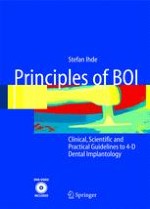Gepubliceerd in:
2005 | OriginalPaper | Hoofdstuk
16. Tuberopterygoid Screws
Abstract
Since panoramic radiographs are obtained by sectional imaging, they will only reveal the structures located in the focused plane. The X-ray system is adjusted in such a way that both the maxilla and the mandible are depicted about equally well in the same image, despite the fact that both jaws are not in the same vertical plane even in patients with intact dentitions. This discrepancy is even greater in edentulous situations, as the maxilla and mandible are characterized by a centripetal and centrifugal resorption pattern, respectively. The discrepancy is greatest in the tuberosity region, since the maxilla almost appears round in that area, and the distalmost parts as well as the palatal bone and the muscular processes of the sphenoid bone fall completely outside the OPG plane. Therefore, inability to depict bone in the tuberosity area using conventional panoramic radiographs does not furnish any evidence of bone resorption but constitutes a typical false-negative finding. The distal maxilla is just as stable to resorption as the mandibular anterior segment because it harbours attachments of powerful chewing muscles. The bone volume in that area is usually abundant as well, so that long screw implants with high anchorage potential can be readily inserted. We do think that this strategy is indicated because implants of this type will help to improve stability and support in this area of high masticatory forces.
